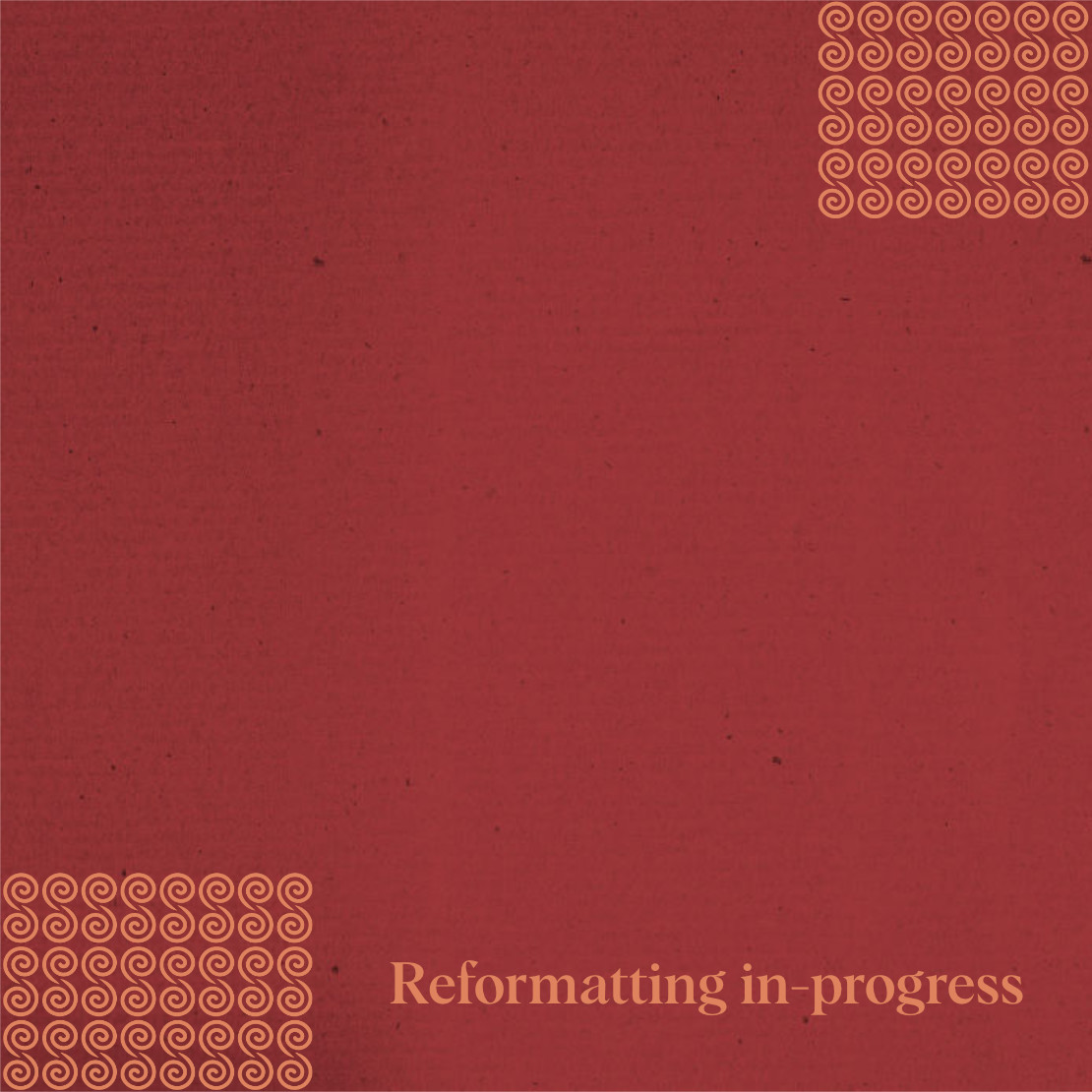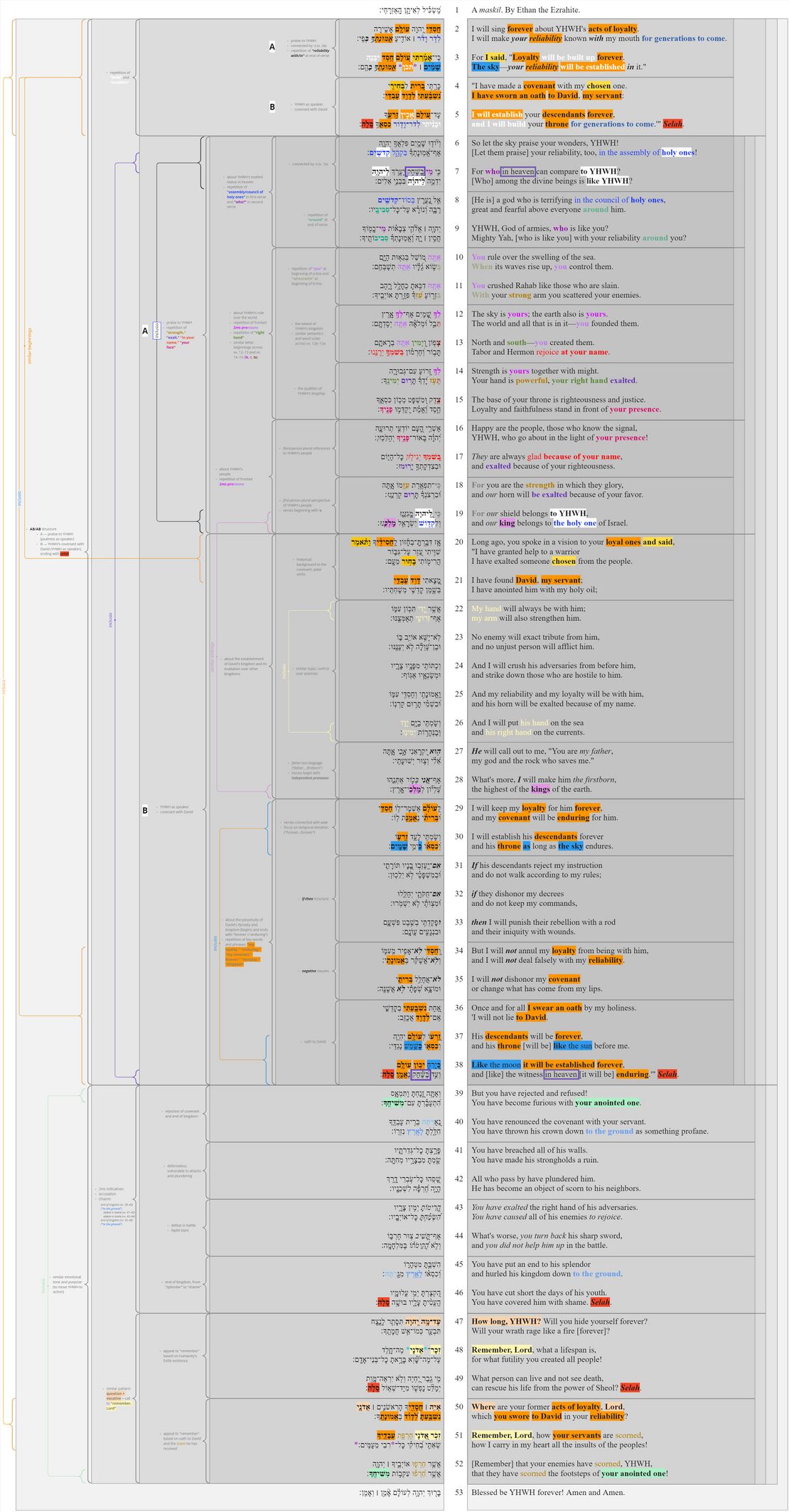Psalm 89 Poetic Structure
Poetic Structure
In poetic structure, we analyse the structure of the psalm beginning at the most basic level of the structure: the line (also known as the “colon” or “hemistich”). Then, based on the perception of patterned similarities (and on the assumption that the whole psalm is structured hierarchically), we argue for the grouping of lines into verses, verses into sub-sections, sub-sections into larger sections, etc. Because patterned similarities might be of various kinds (syntactic, semantic, pragmatic, sonic) the analysis of poetic structure draws on all of the previous layers (especially the Discourse layer).
Poetic Macro-structure
If an emendation or revocalization is preferred, that emendation or revocalization will be marked in the Hebrew text of all the visuals.
| Emendations/Revocalizations legend | |
|---|---|
| *Emended text* | Emended text, text in which the consonants differ from the consonants of the Masoretic text, is indicated by blue asterisks on either side of the emendation. |
| *Revocalized text* | Revocalized text, text in which only the vowels differ from the vowels of the Masoretic text, is indicated by purple asterisks on either side of the revocalization. |
Notes
The psalm has two main parts: vv. 2–38 / vv. 39–52, with v. 53 as a conclusion to psalm as a whole and to Book III of the Psalter. It is plausible that the two main parts come from different authors, writing at different points in time, the first part (vv. 2–38) by Ethan the Ezrahite (see v. 1), a contemporary of David who writes in celebration of YHWH's loyalty to David, and the second part (vv. 39–52) by the Korahites (see Ps 88:1), who write at a later point in time in response to YHWH's apparent breach of loyalty with David (see further The Identity of Ethan the Ezrahite in Psalm89:1). According to the 19th century Rabbi Moshe Yitzhak Ashkenazi, Ethan the Ezrahite wrote vv. 2–38, and "afterwards, the Levites sang it in the sanctuary. And in the days of one of the Judahite kings (Hezekiah?) they added to it..." This understanding of the psalm's history admittedly involves some speculation, but it does account well for the superscriptions[1] and for the content of the psalm itself (which has a strong break between vv. 2–38 and vv. 39ff). Nevertheless, even if these two parts of the psalm come from different authors, they have now been integrated into a single poem (see especially the repetition of key words from vv. 2–5 in v. 50). Perhaps the second part (vv. 39–52) was written as a direct poetic response to the first part, the original poem (vv. 2–38).[2]
- The first part of the psalm (vv. 2–38) has a clear ABAB structure. The first A-B unit is vv. 2–5 (A = vv. 2–3; B = vv. 4–5). This unit briefly introduces the main themes and genres of the psalm and anticipates the movement of the psalm as a whole (A = praise to YHWH, psalmist as speaker; B = YHWH's covenant with David, YHWH as speaker). The second A-B unit is vv. 6–38 (A = vv. 6–19; B = 20–38) and it develops what was briefly introduced in the first A-B unit. Each A-B unit concludes with Selah.
- A (vv. 2–3). Praise to YHWH (psalmist as speaker) (genre: praise).
- B (vv. 4–5). YHWH's covenant with David (YHWH as speaker) (genre: prophecy), ending in Selah.
- A (vv. 6–19). Praise to YHWH (psalmist as speaker) (genre: praise).
- B (vv. 20–38). YHWH's covenant with David (YHWH as speaker) (genre: prophecy), ending in Selah.
- The first A-B (vv. 2–5) unit functions as an introduction to the psalm and to vv. 6–38 in particular. This opening unit is bound by the repetition of the words "build" and "establish" and the phrase "for generations to come."
- The second A-B unit (vv. 6–38) is considerably longer than the first and constitutes the main body of the poem. It is bound by an inclusio (the phrase "in heaven").
- The "A" section (vv. 6–19) of this larger unit is bound by an inclusio ("holy one," "to YHWH"). This section subdivides into three sub-sections (vv. 6–9; vv. 10–15; vv. 16–19), and each of these subsections further divides into smaller sub-sections.
- The "B" section (vv. 20–38) of this larger unit subdivides into two subsections (vv. 20–28; vv. 29–38), the latter of which is bound by an inclusio (note esp. the words "forever" and "enduring" that begin and end the section respectively). These sections divide further into smaller subsections.
- The second main part of the psalm (vv. 39–52) is bound by an inclusio ("your anointed one"). This part consists of two sections: vv. 39–46, concluding with Selah, and vv. 47–52.[3]
- The first of these sections (vv. 39–46) is dominated by 2ms indicative verbs, describing YHWH's breach of covenant loyalty. There might also be a chiasm here: a. end of kingdom (vv. 39–40) ("to the ground"); b. defeat in battle (vv. 41–42); b. defeat in battle (vv. 43–44); a. end of kingdom (vv. 45–46) ("to the ground").
- The second of these sections (vv. 47–52) has an ABC//ABD structure. A = question ("how long?" // "where?") + vocative; B = "Remember, Lord...!"
- Verse 53 is a conclusion to the whole psalm as well as a conclusion to Book III of the Psalter (cf. the conclusion to Pss 41; 72; 106).
At the highest structural level, the analysis here agrees largely with structure proposed by Baethgen and others:[4] an introduction (vv. 2–5) followed by three main parts (vv. 6–19; vv. 20–38; vv. 39–52). But we would nuance this description as follows: an introduction (A-B: vv. 2–5) followed by two main parts (A: vv. 6–19; B: vv. 20–38), followed, at a later stage, by another main part (vv. 39–52).
Van der Lugt sees "three main sections which are clearly distinguished from each other on the basis of their individuality in terms of literary genre: vv. 2–19 (a hymn of praise), 20–38 (a divine oracle) and 39–52 a complaint."[5] But vv. 2–19 are not purely a "hymn of praise." Rather, these verses include a "divine oracle" within them (vv. 4–5). It is better to see vv. 2–5 as consisting of two parts (A: praise; B: divine oracle), which anticipate the next major two parts of the psalm: the hymn of praise (A: vv. 6–19) and the divine oracle (B: vv. 20–38). This division also better accounts for the occurrence of selah.
Veijola sees a different three-part structure, arguing that the present psalm was composed in three stages: (1) a hymn (vv. 2–3, 6–19); (2) a longer poem about YHWH's covenant with David and its apparent violation (4–5, 20–46); and (3) a petition for YHWH to remember.[6] But this hypothesis fails to account for the inclusio ("your anointed one") that binds vv. 39–52,[7] as well as the strong unity of vv. 2–38 and, in particular, vv. 6–38.[8]
Line Divisions
Line division divides the poem into lines and line groupings. We determine line divisions based on a combination of external evidence (Masoretic accents, pausal forms, manuscripts) and internal evidence (syntax, prosodic word counting and patterned relation to other lines). Moreover, we indicate line-groupings by using additional spacing.
When line divisions are uncertain, we consult some of the many psalms manuscripts which lay out the text in lines. Then, if a division attested in one of these manuscripts/versions influences our decision to divide the text at a certain point, we place a green symbol (G, DSS, or MT) to the left of the line in question.
| Poetic line division legend | |
|---|---|
| Pausal form | Pausal forms are highlighted in yellow. |
| Accent which typically corresponds to line division | Accents which typically correspond to line divisions are indicated by red text. |
| | | Clause boundaries are indicated by a light gray vertical line in between clauses. |
| G | Line divisions that follow Greek manuscripts are indicated by a bold green G. |
| DSS | Line divisions that follow the Dead Sea Scrolls are indicated by a bold green DSS. |
| M | Line divisions that follow Masoretic manuscripts are indicated by a bold green M. |
| Number of prosodic words | The number of prosodic words are indicated in blue text. |
| Prosodic words greater than 5 | The number of prosodic words if greater than 5 is indicated by bold blue text. |
If an emendation or revocalization is preferred, that emendation or revocalization will be marked in the Hebrew text of all the visuals.
| Emendations/Revocalizations legend | |
|---|---|
| *Emended text* | Emended text, text in which the consonants differ from the consonants of the Masoretic text, is indicated by blue asterisks on either side of the emendation. |
| *Revocalized text* | Revocalized text, text in which only the vowels differ from the vowels of the Masoretic text, is indicated by purple asterisks on either side of the revocalization. |
Notes
- The line division for this psalm is fairly straightforward. The only difficulties are in vv. 8–9 (discussed in Grammar), v. 20, and v. 53.
- The analysis here agrees completely with that of Veijola 1982, 23–26.
- Every verse consists of two lines, except for v. 20, which has three lines, and v. 53, which consists of a single line.
- vv. 8–9. On the line division in vv. 8–9, see grammar notes. The division here follows the Septuagint for both lines.
- v. 20. It is not clear whether וַתֹּ֗אמֶר is part of the preceding line or the following line. (The Septuagint groups it with the following line, and Jerome groups it with the preceding line.) We have grouped it with the preceding line, because (1) it corresponds more closely with this line semantically ("you spoke... and said"), and (2) this division results in a nice balanced parallel between v. 20b and v. 20c, (eight syllables // eight syllables), which are semantically similar. (In this case, the relation of the accents to the line division is not clear. For the revia over וַתֹּ֗אמֶר, we might have expected ole we-yored.)
- v. 53. The Leningrad Codex (according to BHS and OSHB) reads לְ֝עוֹלָ֗ם. The accent here is revia muggrash. The Aleppo Codex has revia without the geresh (= revia replacing atnach),[9] which is what we would expect in this situation.[10] If we follow the Aleppo Codex and remove the geresh, then we would mark the accent on לְעוֹלָ֗ם as indicating a line division (cf. the line division in EC1 above). The Septuagint (according to the manuscript tradition [e.g., S, B, A, 1219, 2039, 2110] and not according to Rahlfs' edition) presents v. 53 as a single line.
- ↑ Ps 89:1 and Ps 88:1 (which has a double superscription, the first of which stands over Pss 88–89 as a unit, so Hengstenberg).
- ↑ On the unity of the present poem, see e.g., Ward 1961.
- ↑ Cf. van Wolde 2019.
- ↑ Baethgen 1904, 274; see also Pohl 2015.
- ↑ Van der Lugt 2010, 474; so also Hossfeld and Zenger 2000, 406–407; Ellison 2024, 5.
- ↑ Veijola 1982, 47–52.
- ↑ So van der Lugt 2010, 477.
- ↑ On the difficulty of separating vv. 47–52 from the rest of the poem, see Barbiero 2007.
- ↑ Cf. Ginsburg 1913, 199.
- ↑ See Yeivin 1980, #363; de Hoop and Sanders 2022, §6.2.




